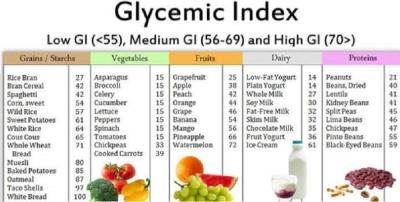Free Link Directory Website
Advertisements

Understanding the Glycemic Index
Basically, the glycemic index is a measure of how certain foods affect your blood sugar, making it a popular tool for managing diabetes and weight in general. For diabetics, keeping a stable blood sugar level is essential to maintain health and avoid the many complications elevated blood sugar can cause, from neuropathy to kidney damage and more. For dieters, keeping the blood sugar level in a normal range helps prevent the storage of fat and allows the body to more easily use up the excess energy stores it already has, which means burning and losing fat.
In general, the higher the glycemic index of a food, the higher a food raises the blood sugar. The lower the glycemic index, the less impact it has on blood sugar. Generally speaking, proteins and fats don’t affect the blood sugar, only carbohydrates.
When the glycemic index was being developed, test subjects were fed various foods and then had their blood sugar levels measured. The resulting glycemic index number was based on an average response, as no two people react exactly alike to different foods. The glycemic index number of 100 was assigned to plain white table sugar and all other foods were ranked either above or below that number depending on how they compared.
If you haven’t read much about the glycemic index, you may be surprised to find out that there are foods that can raise your blood sugar even higher than eating plain white table sugar! The widely accepted wisdom that complex carbohydrates are better for you than simple carbohydrates gets turned on its ear when you factor in the glycemic index – some foods, such as baked potatoes, can be as bad for you in terms of elevated blood sugar as candy.
Generally speaking though, foods are considered to be low, medium or high in terms of the glycemic index. The lowest foods are lean protein sources and fats. These foods have minimal effect on blood sugar. Foods in their natural state usually have a lower glycemic index than they do if they’re processed. Even potatoes, which have a high glycemic index to begin with, go even higher when they’re processed into potato chips. The same thing happens with whole grains. Whole grains may have a low or moderate glycemic index ranking, but they more they’re refined and processed – turned into white flour, for example – the higher their glycemic index ranking climbs.
There’s one additional term you may hear when studying the glycemic index, and that’s the glycemic load. This is a measure not just of an individual food, but of how a meal or combination of foods affects you. There are certain things known to slow or lessen the glycemic index of a food. For example, if you eat a carbohydrate food like brown rice alone, it will impact your blood sugar faster and make it go higher than if you eat that same brown rice with a pat of butter and some baked chicken along side. And since we seldom eat foods one at a time, knowing about the glycemic load can be helpful, even if the math can be a bit cumbersome.
Overall, if you eat only foods that have a glycemic index of 50 or less, you’ll be eating a low glycemic diet. If you’re a diabetic, you should be aware that reducing the glycemic index of the foods you eat can dramatically decrease your need for insulin. However, it’s important to monitor your blood sugar levels closely and decrease your glycemic index gradually to avoid problems.
Copyright © 2022 - All Rights Reserved.

